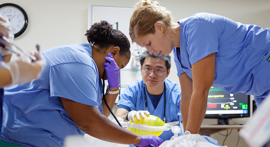
Shadowing entails following a doctor during the course of day-to-day work in a clinic, hospital, or operating room.
Why Shadow a Doctor
Shadowing can be useful at various stages of your pre-medical academic career. It can help you during high school as you try to figure out which college programs you’d like to apply to. During college, it can further help you as you choose a major . Shadowing also affords you the hands-on experience and exposure that will (a) give you a sense of what working with patients and their families is like, and (b) demonstrate your dedication to becoming a physician.
How Many Shadowing Hours do you Need for Medical School?
Shadowing allows you to get a clear sense of what it’s like to be a practicing doctor. For this reason, many medical schools across North America have a minimum requirement for shadowing hours. This may vary widely; some schools require 12–24 hours, while others require more than 75 hours. There are schools (particularly in Canada) that do not require any shadowing hours. Regardless of shadowing requirements, some schools maintain that shadowing experiences can make applicants more competitive in the admissions process.
How to Shadow a Doctor
Typically you’ll have to arrange shadowing opportunities yourself. Shadowing can be arranged in half- or full-day stints (typically from four to eight hours). It can be done on single occasions or arranged over multiple days. The length of the shadowing experience depends on the doctor’s clinic hours and availability as well as the student’s preferences and needs. Here’s what you’ll need to know to get started:
Identifying Specialties of Interest
To begin your search for shadowing opportunities, you’ll need to identify specialties of interest. Start by reflecting on whether you are interested in a medical or surgical specialty. Common medical specialties include family medicine, internal medicine, and pediatrics. Surgical specialties are typically more procedural; they also tend to be operating room (OR)–based. Some common surgical specialties include general surgery, ophthalmology, thoracic surgery, and otolaryngology.
At this stage, it is common for many students not to have a clear direction about what they want to pursue. As pre-medical students or junior trainees, you’re likely to benefit from shadowing physicians in both medical and surgical specialties to gain exposure and learn about the scope of practice. For this reason, many students during their first and second years of medical school (the pre-clerkship years) will often seek shadowing opportunities in various specialties. As your focus becomes more defined, you should also try to shadow doctors in your particular area(s) of interest.
Finding Shadowing Opportunities
Once you have narrowed your options to a few specialties, start by contacting your college’s pre-med advisor. That person can help you connect with a network of physicians, among whom are likely to be alumni. If you have friends in medical school, you can also ask them to refer you to the physicians they shadowed as pre-meds. Your family doctor may even be able to connect you with colleagues.
Some hospitals, particularly in Canada, have affiliations with medical schools and offer summer programs for students. By pairing high school or college students with mentors, these programs provide terrific opportunities for shadowing experiences. If your school has such a program, avail yourself of it!
Contacting Physicians
Unless you’re arranging shadowing opportunities through a school program, then you’ll need to reach out to physicians directly. Start by sending an email. Use a formal letter-writing style (do not address the doctor by first name or use a greeting such as “Hey”). Introduce yourself, note your stage of training, ask directly to shadow that doctor, and describe what you hope to get out of the experience. You can also outline why you are interested in medicine. Attach your résumé to provide more information about your background and accomplishments. Many doctors enjoy teaching and would be excited to share their journey and experiences with you.
Once the doctor has agreed to allow you to shadow her or him, be sure to confirm some important details about your shadowing experience—including where the clinic or hospital is located as well as the duration of your shadowing experience. You’ll also want to confirm whether there is any paperwork (e.g., patient confidentiality forms and/or student agreement forms) that must be completed prior to shadowing. Parents/guardians may be asked to sign additional forms for minors seeking shadowing opportunities.
How to Make the Most of Your Shadowing Experience
Ensure that you are punctual. If you are shadowing in a clinic, be sure to wear professional attire. If you are going to be shadowing in an OR, confirm with the surgeon where you can obtain scrubs. (These are typically available in the hospital.) You should plan to wear closed-toe, comfortable shoes. Bring a small notebook and writing implements so that you can take notes—but do not write down any confidential patient data or information.
It is important to be respectful to everyone you encounter during your shadowing experience—including patients, their families, administrative staff, and other allied health professionals. It is also important to demonstrate your enthusiasm and interest while working with a doctor. Make note of any questions you may have and ask them politely at an appropriate time. (You may have such an opportunity during a break or at the end of the day.)
Before you leave, thank the doctor and the team for having you in. If possible, set up another shadowing experience with the doctor before you leave. If you’re still looking for additional shadowing opportunities, ask your host physician to recommend colleagues you could contact.
What To Do After Shadowing a Doctor
First things first: Send a thank-you email or card to the physician you shadowed. Additionally, keep a journal in which you write any reflections and experiences that stood out to you. Referring back to these experiences can be beneficial when you write your personal statements for medical school . (Again, you’ll want to maintain patient confidentiality, so stay focused on the overall experience.) Make the most of the opportunity to think more about where you’d like to direct your specialized study.
After you’re done shadowing—and after you’ve completed your medical training—remember to pay it forward and say “Yes!” when an aspiring physician asks to shadow you!
Read More
Explore Graduate Programs for You
Explore our featured graduate schools & programs to find those that both match your interests and are looking for students like you.
Best Law Schools
Check out our complete list of 168 law schools, based on surveys of school administrators and over 17,000 students.
Search for Medical Schools
Visit our Med School Hub to explore med schools with our ‘Find Your Med School’ filtered search or visit our Med School Advice pages for info about good MCAT scores or interview question prep.

Find MBA Programs Matched to Your Interests
Explore our featured business schools to find those that are looking for students like you.


